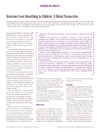Please use this identifier to cite or link to this item:
https://accedacris.ulpgc.es/handle/10553/44726
| Title: | Television food advertising to children: A global perspective | Authors: | Kelly, Bridget Halford, Jason C.G. Boyland, Emma J. Chapman, Kathy Bautista-Castaño, Inmaculada Berg, Christina Caroli, Margherita Cook, Brian Coutinho, Janine G. Effertz, Tobias Grammatikaki, Evangelia Keller, Kathleen Leung, Raymond Manios, Yannis Pedley, Claire Prell, Hillevi Raine, Kim Recine, Elisabetta Serra-Majem, Lluis Singh, Sonia Summerbell, Carolyn |
UNESCO Clasification: | 32 Ciencias médicas 3206 Ciencias de la nutrición |
Keywords: | Australia Food advertising Child |
Issue Date: | 2010 | Publisher: | 0090-0036 | Journal: | American Journal of Public Health | Abstract: | Objectives. We compared television food advertising to children in several countries. Methods. We undertook a collaboration among 13 research groups in Australia, Asia, Western Europe, and North and South America. Each group recorded programming for 2 weekdays and 2 weekend days between 6:00 and 22:00, for the 3 channels most watched by children, between October 2007 and March 2008. We classified food advertisements as core (nutrient dense, low in energy), noncore (high in undesirable nutrients or energy, as defined by dietary standards), or miscellaneous. We also categorized thematic content (promotional characters and premiums). Results. Food advertisements composed 11% to 29% of advertisements. Noncore foods were featured in 53% to 87% of food advertisements, and the rate of noncore food advertising was higher during children's peak viewing times. Most food advertisements containing persuasive marketing were for noncore products. Conclusions. Across all sampled countries, children were exposed to high volumes of television advertising for unhealthy foods, featuring child-oriented persuasive techniques. Because of the proven connections between food advertising, preferences, and consumption, our findings lend support to calls for regulation of food advertising during children's peak viewing times. | URI: | https://accedacris.ulpgc.es/handle/10553/44726 | ISSN: | 0090-0036 | DOI: | 10.2105/AJPH.2009.179267 | Source: | American Journal Of Public Health [ISSN 0090-0036], v. 100 (9), p. 1730-1736 |
| Appears in Collections: | Artículos |
SCOPUSTM
Citations
331
checked on May 18, 2025
WEB OF SCIENCETM
Citations
297
checked on May 11, 2025
Page view(s)
93
checked on Nov 9, 2024
Download(s)
504
checked on Nov 9, 2024
Google ScholarTM
Check
Altmetric
Share
Export metadata
Items in accedaCRIS are protected by copyright, with all rights reserved, unless otherwise indicated.
